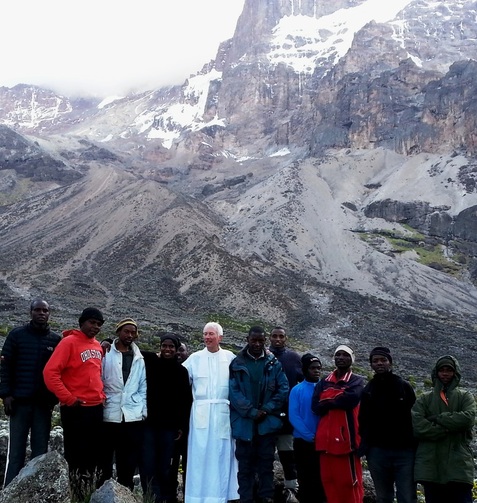 Mass with porters at Barranca Camp (13,000 feet) on the way up Mount Kilimanjaro.
Mass with porters at Barranca Camp (13,000 feet) on the way up Mount Kilimanjaro. A Public Holiday
The Church celebrates the Feast of Corpus Christi as a “public” holy day. Obviously not everyone celebrates it, but Corpus Christi is “public” because Jesus gives his flesh not only for Catholics but “for the life of the world.” Manna, the Old Testament symbol of the Eucharist, was given only to the Jewish people. Christ gives His body, however, to the whole world, and we receive it on behalf of the entire human race. If only “the public” would eat this bread, we would have peace on earth and endless life in heaven! Mother Teresa often said that Jesus is the bread to be broken, and we become that bread when we receive him. As His broken body heals the brokenness of humanity, so our brokenness, in Christ, heals “the public.” That is your essential vocation as Missionaries of Charity: not just to give bread to the poor, but to be bread for the poor.
Justin the Atheist
St. John Paul wrote that, by bearing the Eucharist in procession through city streets, “the Church proclaims that the sacrifice of Christ is for the whole world.” When John Paul offered public Mass for a million people in Warsaw in 1979, and when he offered the Body of Christ to five million in Manila’s city square in 1995, and when he gave the Body of Christ to 12 million in Mexico City in 2002, he did so not just for those Catholics present, but for the entire world. And the entire world received blessing from that Mass in Warsaw, which ultimately led to the overthrow of communist regimes in all of Eastern Europe.
Last week I hiked for a week with a young man from Colorado named Justin. Educated in American public schools, which exclude any mention of God, he said he didn’t believe in God or in anything he couldn’t see. Three times the Holy Spirit gave me the right moment to speak to him about God’s love without awkwardness, and each time Justin expressed polite non-responsiveness. He could see how many Tanzanian porters attended morning Mass on the trail, but he could also see that no European or Americans paid the least attention to the things of God on our journey. Justin and other wealthy unbelievers are that public for whom this feast of Corpus Christi is also offered. Justin is dying from hunger but doesn’t know it; who will receive the bread of life for him?
Sacrifices made all for thee
Mother begged you sisters to offer your afflictions for the love of Jesus and the poor. “Our chalices,” she wrote, “will be filled with sacrifices made all for thee.” In the First reading, Moses explains that God allowed the Israelites to suffer hunger, and then fed them with manna in order to convince them that man does not live by bread alone. It was the Lord who guided them through that “vast and terrible desert” with its serpents and scorpions, its parched and waterless ground, bringing forth water from the rock and manna from the sky. Thus Moses explains why God allows suffering? Only through the humility of deprivation do we learn to trust Him, and learn to love Him. The public is dying of hunger for love, for meaning, for God, but it is so drugged on cheap substitutes that it doesn’t know it. My friend Justin, for example, desperately seeks to convince himself that he is happy, or as happy as one can be in a sad and meaningless world. God will allow Justin to suffer in the hope that he will learn to love and trust Him. Let us trust the divine physician’s treatment for our spiritual sickness when we suffer or see pain in others.
Corpus Christi priests
In 1981, Fr. Joseph Langford and some other priests wanted to work more closely with Mother for the poorest of the poor. They wanted a share in the secret fire that radiated from this little Albanian nun. At first this little group called itself the “Priestly coworkers of Mother Teresa.” But Mother soon changed the name to the “Corpus Christi Movement of Priests.” Why did Mother choose the name of Corpus Christi? I think it was because she wanted to remind priests of their essential purpose: to bring the Eucharist from heaven to earth “for the life of the world.” Mother also knew the essential purpose of your Society is to touch the Body of Christ, first in the Holy Mass and then in the poorest of the poor. “It is the same Jesus.”
Let us learn how to touch the fragile Body of Christ from that Mother who first received Him on earth. Our Lady knows how to receive him perfectly, as she did at the Annunciation, and will teach us how to receive the Body of Christ, both in the Eucharist and in poverty-stricken humanity. We can receive Him with the purity of her Immaculate Heart, if we stay devoted to her.


 RSS Feed
RSS Feed